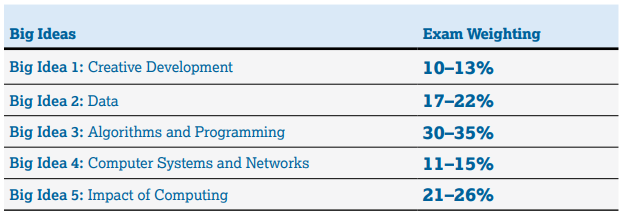
8.2. About the AP CS Principles Exam¶
The AP Computer Science Principles exam questions assess both the application of the computational thinking practices and an understanding of the big ideas. Exam questions may assess achievement of multiple learning objectives. They may also address content from more than one essential knowledge statement. Exam questions may be accompanied by non-textual stimulus material such as diagrams, charts, or other graphical illustrations.
The AP Computer Science Principles Exam:
- 70 multiple-choice questions (120 minutes (2 hours) long, 70% of your grade):
- 57 single-select multiple-choice
- 5 single-select with reading passage about a computing innovation
- 8 multiple-select multiple-choice: select 2 answers
- As of 2024, there are 4 written response question prompts for an additional 60 minutes on the exam using the Create Personalized Project Reference created during the Create Task. Along with your Create video and Program Code (10%), this portion is worth 30% of the exam.
The following table shows what percentage of questions are in each of the Big Ideas in CSP:
Reference Sheet:
The AP CS Principles Exam does not have a designated programming language associated with it. Therefore, a reference sheet is provided to give instructions and explanations to help you understand the format and the meaning of the questions on the exam. The reference sheet can be seen below. It includes two programming formats: text-based and block-based. Be sure to review the reference sheet ahead of time and be familiar with the material that it has on it. The next lesson reviews AP pseudocode and compares it to App Inventor Blocks.
Learning Objectives
As described in the AP CSP Guide, here are the learning objectives covered in the AP CSP exam:
8.2.1. Summary¶
In this lesson, you learned about the distribution of questions in the AP CSP Exam.